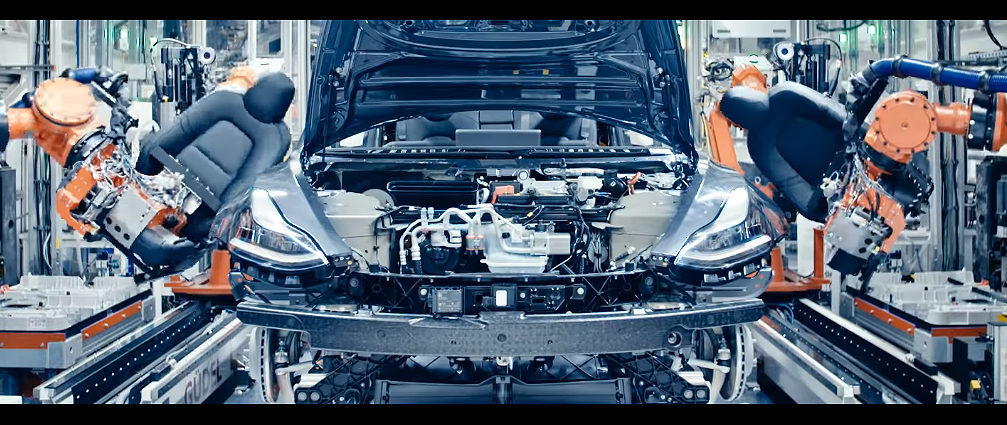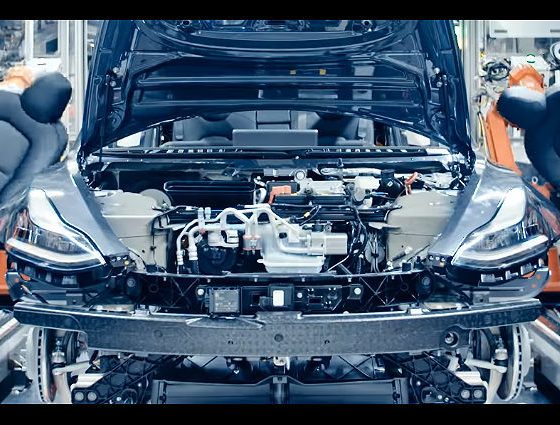

Investor's Corner
Tesla Model 3 VINs surpass 42k total registrations to date
Just days after registering more than 5,000 new Model 3 VINs, Tesla filed another 3,661 vehicle identification numbers for its compact electric car. With the addition of this latest batch, Tesla has now registered a total of 42,942 VINs for the Model 3.
The new Model 3 VINs were posted on Twitter by @Model3VINs, a group that tracks Tesla’s registrations for the electric car. A month ago, the highest VIN registered by Tesla was #28296, despite the vehicle already being in production for months. Since then, the number of VINs have increased by more than 50%.
This week alone, Tesla registered more than 8,000 new Model 3 VINs, a feat that took Tesla months to accomplish since starting production of the electric car last year. Looking at past VIN tracker reports, Tesla was only able to breach the VIN#8,000 barrier late December, despite the vehicle starting production in mid-2017.
#Tesla registered 3,661 new #Model3 VINs. Highest VIN is 42942. https://t.co/k4EnfTbGNZ
— Model 3 VINs (@Model3VINs) May 11, 2018
During Tesla’s first-quarter earnings call, Elon Musk stated that the company had become a “leaky server of information.” Musk even noted that any information on the Model 3 line that he mentions in the call would likely become public knowledge after a few weeks, considering that shipments and registrations for the car are being carefully tracked and monitored.
“People track registrations very closely. So at most, any information that we provide would be 1 week or 2 in advance of what will become public knowledge just due to vehicle registrations and shipments that are tracked very carefully,” Musk said.
Tesla’s more than 8,000 new Model 3 VINs that were filed this week seems to be in line with the estimates outlined in a leaked email from Elon Musk last month. In that particular email, Musk stated that the scheduled shutdown of the Model 3 line last April is expected to pave the way for the company to hit a production rate of 3,000-4,000 Model 3 per week.
Another shutdown is expected this May, which would, in turn, enable the Model 3 line to boost production to 5,000-6,000 vehicles per week. Once Tesla hits a steady production rate of 5,000 Model 3 per week, the company would start rolling out new variants of the vehicle, such as dual-motor AWD.
Elon Musk has boldly declared that Tesla would be profitable by the third or fourth quarter this year. In order for the electric car maker to accomplish this, the Model 3 line must be working at optimum pace. Musk highlighted this during the Q1 2018 earnings call, when he stated that time is right for Tesla to start making a profit.
Musk doubled down on his statements on Twitter as well, stating that the “short burn of the century” would be coming soon. Emphasizing his point, Musk also bought nearly $10 million worth of TSLA shares, taking the battle directly to the company’s critics.
As of writing, Tesla stocks (NASDAQ:TSLA) are trading down .01% at $305.00 per share during Friday’s pre-market.

Investor's Corner
Tesla stock closes at all-time high on heels of Robotaxi progress

Tesla stock (NASDAQ: TSLA) closed at an all-time high on Tuesday, jumping over 3 percent during the day and finishing at $489.88.
The price beats the previous record close, which was $479.86.
Shares have had a crazy year, dipping more than 40 percent from the start of the year. The stock then started to recover once again around late April, when its price started to climb back up from the low $200 level.
This week, Tesla started to climb toward its highest levels ever, as it was revealed on Sunday that the company was testing driverless Robotaxis in Austin. The spike in value pushed the company’s valuation to $1.63 trillion.
Tesla Robotaxi goes driverless as Musk confirms Safety Monitor removal testing
It is the seventh-most valuable company on the market currently, trailing Nvidia, Apple, Alphabet (Google), Microsoft, Amazon, and Meta.
Shares closed up $14.57 today, up over 3 percent.
The stock has gone through a lot this year, as previously mentioned. Shares tumbled in Q1 due to CEO Elon Musk’s involvement with the Department of Government Efficiency (DOGE), which pulled his attention away from his companies and left a major overhang on their valuations.
However, things started to rebound halfway through the year, and as the government started to phase out the $7,500 tax credit, demand spiked as consumers tried to take advantage of it.
Q3 deliveries were the highest in company history, and Tesla responded to the loss of the tax credit with the launch of the Model 3 and Model Y Standard.
Additionally, analysts have announced high expectations this week for the company on Wall Street as Robotaxi continues to be the focus. With autonomy within Tesla’s sights, things are moving in the direction of Robotaxi being a major catalyst for growth on the Street in the coming year.
Elon Musk
Tesla needs to come through on this one Robotaxi metric, analyst says
“We think the key focus from here will be how fast Tesla can scale driverless operations (including if Tesla’s approach to software/hardware allows it to scale significantly faster than competitors, as the company has argued), and on profitability.”

Tesla needs to come through on this one Robotaxi metric, Mark Delaney of Goldman Sachs says.
Tesla is in the process of rolling out its Robotaxi platform to areas outside of Austin and the California Bay Area. It has plans to launch in five additional cities, including Houston, Dallas, Miami, Las Vegas, and Phoenix.
However, the company’s expansion is not what the focus needs to be, according to Delaney. It’s the speed of deployment.
The analyst said:
“We think the key focus from here will be how fast Tesla can scale driverless operations (including if Tesla’s approach to software/hardware allows it to scale significantly faster than competitors, as the company has argued), and on profitability.”
Profitability will come as the Robotaxi fleet expands. Making that money will be dependent on when Tesla can initiate rides in more areas, giving more customers access to the program.
There are some additional things that the company needs to make happen ahead of the major Robotaxi expansion, one of those things is launching driverless rides in Austin, the first city in which it launched the program.
This week, Tesla started testing driverless Robotaxi rides in Austin, as two different Model Y units were spotted with no occupants, a huge step in the company’s plans for the ride-sharing platform.
Tesla Robotaxi goes driverless as Musk confirms Safety Monitor removal testing
CEO Elon Musk has been hoping to remove Safety Monitors from Robotaxis in Austin for several months, first mentioning the plan to have them out by the end of 2025 in September. He confirmed on Sunday that Tesla had officially removed vehicle occupants and started testing truly unsupervised rides.
Although Safety Monitors in Austin have been sitting in the passenger’s seat, they have still had the ability to override things in case of an emergency. After all, the ultimate goal was safety and avoiding any accidents or injuries.
Goldman Sachs reiterated its ‘Neutral’ rating and its $400 price target. Delaney said, “Tesla is making progress with its autonomous technology,” and recent developments make it evident that this is true.
Investor's Corner
Tesla gets bold Robotaxi prediction from Wall Street firm
Last week, Andrew Percoco took over Tesla analysis for Morgan Stanley from Adam Jonas, who covered the stock for years. Percoco seems to be less optimistic and bullish on Tesla shares, while still being fair and balanced in his analysis.

Tesla (NASDAQ: TSLA) received a bold Robotaxi prediction from Morgan Stanley, which anticipates a dramatic increase in the size of the company’s autonomous ride-hailing suite in the coming years.
Last week, Andrew Percoco took over Tesla analysis for Morgan Stanley from Adam Jonas, who covered the stock for years. Percoco seems to be less optimistic and bullish on Tesla shares, while still being fair and balanced in his analysis.
Percoco dug into the Robotaxi fleet and its expansion in the coming years in his latest note, released on Tuesday. The firm expects Tesla to increase the Robotaxi fleet size to 1,000 vehicles in 2026. However, that’s small-scale compared to what they expect from Tesla in a decade.
Tesla expands Robotaxi app access once again, this time on a global scale
By 2035, Morgan Stanley believes there will be one million Robotaxis on the road across multiple cities, a major jump and a considerable fleet size. We assume this means the fleet of vehicles Tesla will operate internally, and not including passenger-owned vehicles that could be added through software updates.
He also listed three specific catalysts that investors should pay attention to, as these will represent the company being on track to achieve its Robotaxi dreams:
- Opening Robotaxi to the public without a Safety Monitor. Timing is unclear, but it appears that Tesla is getting closer by the day.
- Improvement in safety metrics without the Safety Monitor. Tesla’s ability to improve its safety metrics as it scales miles driven without the Safety Monitor is imperative as it looks to scale in new states and cities in 2026.
- Cybercab start of production, targeted for April 2026. Tesla’s Cybercab is a purpose-built vehicle (no steering wheel or pedals, only two seats) that is expected to be produced through its state-of-the-art unboxed manufacturing process, offering further cost reductions and thus accelerating adoption over time.
Robotaxi stands to be one of Tesla’s most significant revenue contributors, especially as the company plans to continue expanding its ride-hailing service across the world in the coming years.
Its current deployment strategy is controlled and conservative to avoid any drastic and potentially program-ruining incidents.
So far, the program, which is active in Austin and the California Bay Area, has been widely successful.








